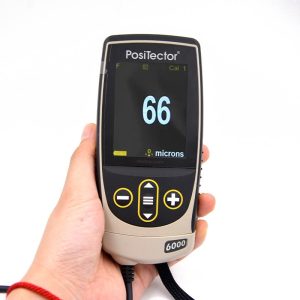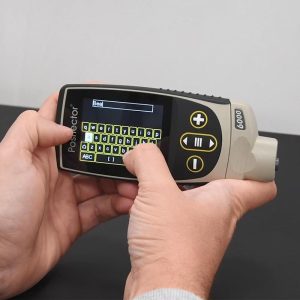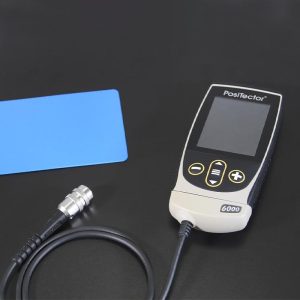All changes are inseparable: several calibration methods of paint film thickness gauge
Overview
Film thickness gauge is a special instrument used to measure the thickness of coating or paint film. It is widely used in the paint, coating, and surface treatment industry to evaluate the quality, uniformity, and compliance of coatings.
The working principle of the film thickness gauge is based on the absorption and reflection characteristics of different materials to electromagnetic waves. Common paint film thickness gauges use non-destructive testing methods to determine the thickness of the coating by placing a measuring head or probe on the surface of the coating, emitting electromagnetic waves into the coating, and then measuring the reflected signal. Instruments usually have high accuracy and reliability and can be adapted to different types of coatings such as paints, anti-corrosion coatings, electroplating, etc.
Film thickness gauges are used in a wide range of applications, including real-time monitoring on automated production lines, quality control and quality assurance, comparative analysis before and after coating construction, coating wear and corrosion assessment, etc. By measuring the thickness of the coating, it is possible to determine its compliance with the requirements of the code, as well as predict its performance and durability. The advantages of film thickness gauges are that they are fast, accurate, non-destructive and easy to operate. It provides an important tool for ensuring the quality and consistency of the coating, as well as controlling the coating thickness during the production process.

All changes are inseparable: several calibration methods of paint film thickness gauge
Purpose of calibration
The paint thickness gauge is calibrated to ensure the accuracy and reliability of the measurement results. Through calibration, the accuracy of the thickness measuring instrument can be verified and the measurement results can be consistent with the actual coating thickness. This is essential to meet quality standards, meet industry requirements, and improve product consistency. Calibration of the film thickness gauge is performed regularly to ensure stable performance of the instrument and provide reliable measurement data to aid in quality control and quality assurance in the production process. Whether in the coating industry, the field of anti-corrosion coatings, or other coating applications, calibration is a necessary step to ensure accurate measurement of coating thickness, thereby guaranteeing product quality and performance.
Method of calibration
Several common calibration methods of paint film thickness gauge include:
Reference plate calibration: A reference plate of known thickness is used for calibration. The reference sheet is usually a metal sheet or calibration sheet with an accurate calibrated thickness. The reference sheet is placed under the measuring head, and the measuring instrument reads the thickness of the reference sheet and calibrates it.
Zero calibration: Zero calibration is performed on uncoated substrates. Place the measuring head on the substrate and set the measuring instrument to zero so that it reads zero. This calibration method is suitable for measuring the thickness of non-coated substrates.
Multi-point calibration: Calibration is performed using multiple reference plates of known thickness. The accuracy and stability of the measuring instrument can be improved by placing reference pieces of different thickness and calibrating the measuring instrument to each reference piece.
Reflection calibration: Calibration is performed using samples with known coating thickness and substrate reflectivity. By measuring a sample with known coating thickness and entering the reflectivity value of the sample, the measuring instrument can be calibrated and provide more accurate coating thickness measurement results.
Calibration with standard reference samples: Calibration with certified standard reference samples. These reference samples have coatings of known thickness and specific characteristics that can be used as reference standards for calibration.
 All changes are inseparable: several calibration methods of paint film thickness gauge
All changes are inseparable: several calibration methods of paint film thickness gauge
Step of calibration
Depending on the thickness gauge model and manufacturer, other specific calibration methods and procedures may exist. When using a thickness gauge, the operating manual of the instrument should be read carefully and the correct calibration operation should be carried out according to the instructions provided by the manufacturer to ensure the accuracy and reliability of the measurement results.

The following is an example of a general paint film thickness gauge calibration procedure:
Prepare calibration reference plate or standard reference sample: Select the appropriate calibration reference plate or standard reference sample according to the requirements of the thickness measuring instrument. Make sure the samples have a known thickness and are in good condition.
Calibration instrument: According to the operation manual of the instrument, open the thickness gauge and enter the calibration mode. Select the appropriate calibration method according to the specific requirements.
Zero calibration: If using the zero calibration method, place the measuring head on an uncoated substrate and zero the instrument so that it reads zero.
Single point calibration: Place the calibration reference plate under the measuring head, ensure that it is in close contact, and calibrate according to the instructions of the instrument.
All changes are inseparable: several calibration methods of paint film thickness gauge
Multi-point calibration: calibration reference plates of different thickness are used in turn for calibration. Each reference piece was placed below the measuring head, calibrated and the corresponding reading recorded.
Reflection calibration: Prepare samples with known coating thickness and substrate reflectivity. Place the sample below the measuring head and input the reflectivity value of the sample according to the instructions of the instrument for calibration.
Verification calibration: After the calibration is completed, samples with known coating thickness are used for verification. Measure the sample and compare it with known thickness to ensure accurate measurement results.
Please note that the above is only a general example of calibration steps, the actual operation should be carried out according to the specific thickness measuring instrument and the operation manual provided by the manufacturer. Ensure that calibration is carried out strictly in accordance with the instructions of the instrument, and calibration is carried out regularly to ensure the accuracy and reliability of the measurement results.
